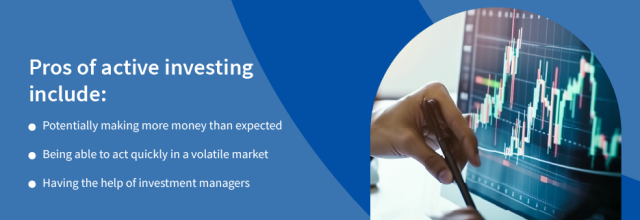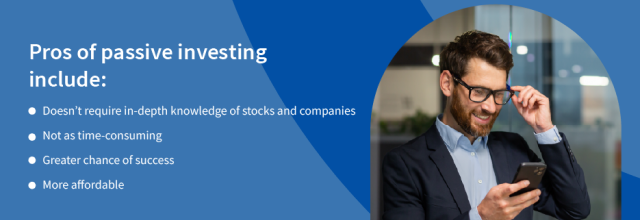Active vs. Passive Investing: Strategies to Know in 2023
Published: 08/17/2023
By: Idaho Trust Bank

Active vs. Passive Investing
When it comes to growing your investment portfolio, there are two approaches to choose from: active and passive investment. Active investment allows you or your investment manager to choose the stocks and bonds you invest in.
On the other hand, passive investment can be a good approach for investors who don’t want to be as involved. You’ll likely need both active and passive investments to future-proof your portfolio. Keep reading to learn more about both approaches to investing and which situations they are best for.
What Is Active Investing?
Active investing uses a hands-on approach to portfolio management. Investors will give their funds to financial managers whose main goal is to beat the growth of standard index funds such as the S&P 500.
Active investing is often what people picture when they envision the stock market. You may imagine investors screaming to buy or sell certain stocks or imagine viral meme stocks turning average Reddit users into millionaires.
However, active investing isn’t as hectic or volatile as it’s depicted in movies. Many active investment fund managers spend countless hours researching companies before choosing to invest in them. With the right resources, active investments can be sustainable investments. You just need to be aware of the benefits and drawbacks of this investment option.
Pros of Active Investing
There are many benefits of using active funds if you have the time and energy to manage them. Active investing is popular with different types of people, from aggressive investors to people who like to be engaged with the companies they buy into. A few advantages of active investing include:
- Potentially making more money than expected. The goal of active investing is to beat standard returns.
- Being able to act quickly in a volatile market. For example, many active investors pulled their money out of the cruise ship industry when the COVID-19 pandemic closed ports.
- Having the help of investment managers. They use their expertise to help deliver the best possible returns on your investment portfolio.
Not only can active investing be used for short-term gains, but it can also be used for long-term growth and goals. For example, active investing could be part of your investment management plan if you are looking to grow your trust or estate.

Cons of Active Investing
Despite the hands-on approach that comes with active investing, this method of wealth management doesn’t always guarantee the best results. For one thing, active investing is more expensive because you have to pay a firm to buy and sell your money across different companies. You must make sure your portfolio gains more it costs you to maintain an active investment approach.
Additionally, active investing doesn’t guarantee success. An active investor needs to know the exact right time to buy or sell stocks. If their timing is off, they could sell too early or too late to turn a significant profit.
If you choose to manage your active investments yourself, you need to stay on top of the companies you invest in and surrounding events that could lower their stock value — anything from changes among board members to failed product launches.
Examples of Active Investing
One of the best ways to understand active investing is to see it in action. This includes individual stock portfolios that are personalized based on the investor's level of risk tolerance. Personal investment apps, where people can buy and sell stocks they think will be successful, are another form of active investing.
What Is Passive Investing?
Passive investing takes a long-term approach to money management. Investors place their funds in a variety of diverse industries and let them grow over a period of years.
The goal of passive investing is to match market growth, not beat it. For example, with the S&P 500 Index having a long-term average rate of return of 6.33%, passive investors would expect their funds to match that level of growth. When the market dips, passive investors wait it out. They are confident that it will rebound and continue to grow through the years.
Pros of Passive Investing
Passive investing is a popular choice for a specific type of investor. It’s used by people who want to “set and forget” their stocks for several years. A few benefits of this form of investing include:
- Doesn’t require in-depth knowledge of stocks and companies. Most passive investors choose a general portfolio to buy into.
- Not as time-consuming. Neither the investor nor their money manager needs to spend time tracking the stocks.
- Greater chance of success. It is easier to hit your goals of an average performance instead of trying to do better than everyone else.
- More affordable. Passive investing can be less costly because there are fewer transactions and investment fees.
Most commonly, people participate in passive investment through employer-sponsored retirement accounts. As of March 2022, 69% of private sector workers had access to some sort of retirement account—a statistic that will likely grow with time.

Cons of Passive Investing
While passive investing often seems like the safer route, there are some drawbacks to leaving your money in general growth funds:
- You can’t control where you invest your money, so you may be invested in some industries you do not want to support.
- These stocks are not meant to beat the standard performance, so your investments will not grow more than expected.
Oftentimes, financial managers use passive investing to reduce risk, though long-term success in finance is never guaranteed.
Examples of Passive Investing
There are a variety of passive investment options. A few examples include mutual funds or exchange-traded funds, as well as general 401(k) retirement accounts provided by your employer that use company-generated portfolios. If you are one of the approximately 375,000 private sector workers in Idaho without access to a retirement plan, you can open your own Individual Retirement Account (IRA). These investments are usually easy to set up and don’t require day-to-day management.
Learn more about our investment approach
The journey of investing isn't one-size-fits-all. Both active and passive investing strategies offer unique advantages tailored to different investor mindsets and goals. As an investor, understanding your own risk tolerance, time commitment, and financial objectives is paramount. At Idaho Trust Bank, our LifeNeeds™ portfolio management** utilizes proven strategies and techniques delivered by a highly-trained staff of wealth management professionals. We can help you identify your life goals and plan an investment strategy to help you reach those goals. Learn more about what we do and contact a wealth management expert to discuss your investment needs today.
**NOT A DEPOSIT | NOT FDIC INSURED | NOT INSURED BY ANY FEDERAL GOVERNMENT AGENCY | NOT GUARANTEED BY THE BANK | MAY GO DOWN IN VALUE
